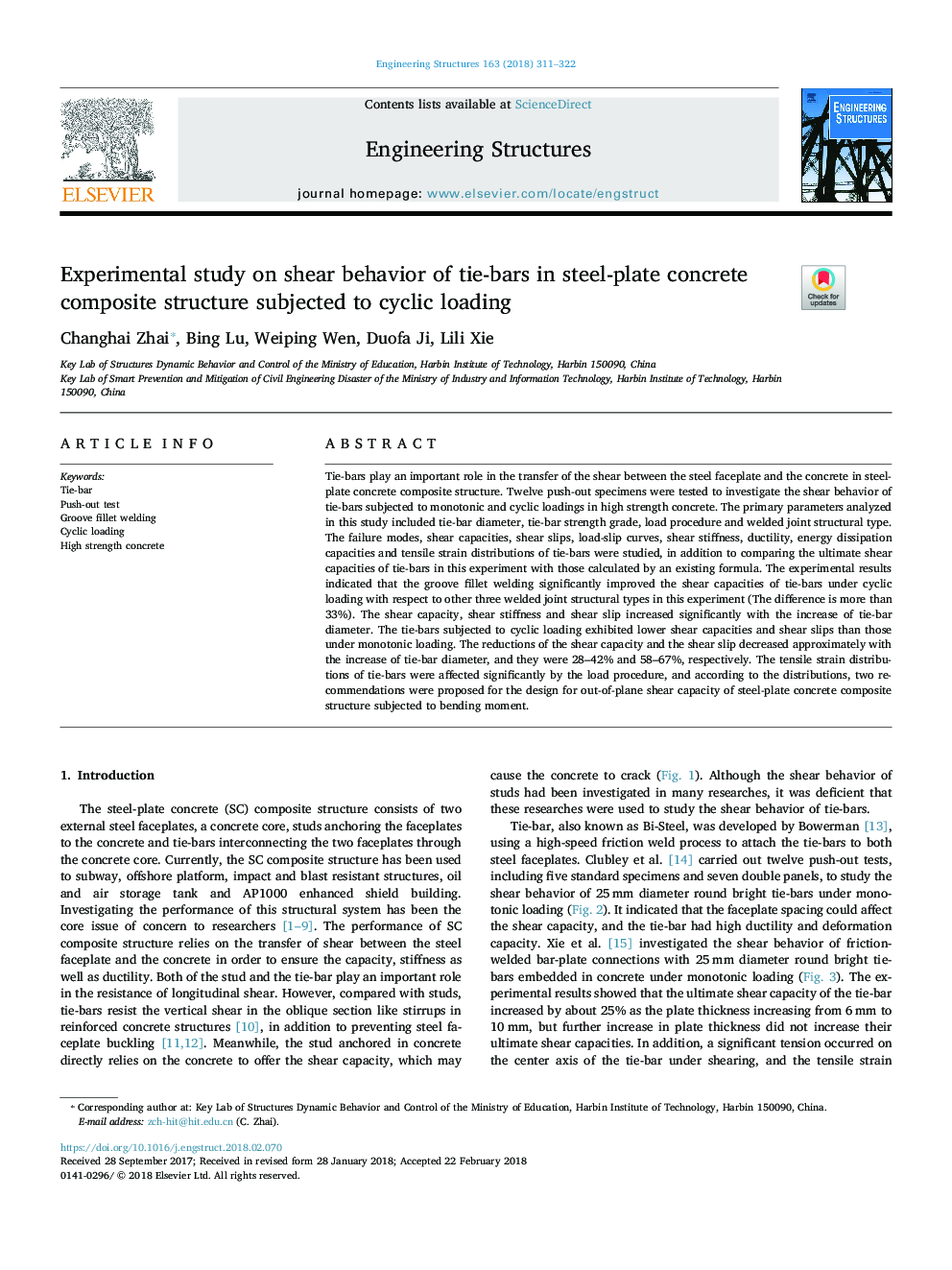| کد مقاله | کد نشریه | سال انتشار | مقاله انگلیسی | نسخه تمام متن |
|---|---|---|---|---|
| 6737804 | 1429064 | 2018 | 12 صفحه PDF | دانلود رایگان |
عنوان انگلیسی مقاله ISI
Experimental study on shear behavior of tie-bars in steel-plate concrete composite structure subjected to cyclic loading
ترجمه فارسی عنوان
مطالعه تجربی بر روی رفتار برشی کراوات در ساختار کامپوزیت بتن فولادی تحت بارگذاری چرخه ای است
دانلود مقاله + سفارش ترجمه
دانلود مقاله ISI انگلیسی
رایگان برای ایرانیان
کلمات کلیدی
نوار تست کشش، جوشکاری دمبرگ، بارگذاری سیکل، بتن با مقاومت بالا،
ترجمه چکیده
کاسه ها نقش مهمی در انتقال برش بین ورق فولادی و بتن در ساختار کامپوزیت بتن فولادی دارند. به منظور بررسی رفتار برشی کراوات در معرض بارهای مونوتونی و چرخه ای در بتن با مقاومت بالا، دوازده نمونه برداشته شد. پارامترهای اصلی تجزیه و تحلیل شده در این مطالعه شامل قطر کراس نوار، درجه استحکام کراوات، روش بار و نوع ساختار مشترک جوش داده شده است. حالتهای شکست، ظرفیت برشی، لغزش برشی، منحنی بار لغزش، سختی برشی، انعطاف پذیری، ظرفیت تخلیه انرژی و توزیع کششی کششی کراوات، علاوه بر مقایسه ظرفیت برشی نهایی کراوات در این آزمایش با کسانی که با فرمول موجود محاسبه می شوند. نتایج تجربی نشان داد که جوش نخی شیار به طور معنی داری ظرفیت برشی کراوات را تحت بارگذاری سیکل با توجه به سه نوع ساختار مجاور جوش داده شده در این آزمایش بهبود می بخشد (تفاوت بیش از 33٪). ظرفیت برشی، سفتی برشی و لغزش برشی با افزایش قطر کراوات افزایش یافت. بارهای چرخه ای که تحت بارگذاری چرخه قرار می گرفتند، ظرفیت برشی پایین و لغزش های برشی را نسبت به بارهای مونوتونی داشتند. کاهش ظرفیت برشی و لغزش برشی با افزایش قطر کراوات تقریبا کاهش یافت و به ترتیب 28-42٪ و 58-67٪ بود. توزیع کرنش کششی کراوات با روش بارگیری به طور معنی داری تحت تاثیر قرار گرفت و با توجه به توزیع، دو پیشنهاد برای طراحی ظرفیت برشی خارج از فونداسیون ساختار کامپوزیت بتن فولادی مورد بررسی قرار گرفت.
موضوعات مرتبط
مهندسی و علوم پایه
علوم زمین و سیارات
مهندسی ژئوتکنیک و زمین شناسی مهندسی
چکیده انگلیسی
Tie-bars play an important role in the transfer of the shear between the steel faceplate and the concrete in steel-plate concrete composite structure. Twelve push-out specimens were tested to investigate the shear behavior of tie-bars subjected to monotonic and cyclic loadings in high strength concrete. The primary parameters analyzed in this study included tie-bar diameter, tie-bar strength grade, load procedure and welded joint structural type. The failure modes, shear capacities, shear slips, load-slip curves, shear stiffness, ductility, energy dissipation capacities and tensile strain distributions of tie-bars were studied, in addition to comparing the ultimate shear capacities of tie-bars in this experiment with those calculated by an existing formula. The experimental results indicated that the groove fillet welding significantly improved the shear capacities of tie-bars under cyclic loading with respect to other three welded joint structural types in this experiment (The difference is more than 33%). The shear capacity, shear stiffness and shear slip increased significantly with the increase of tie-bar diameter. The tie-bars subjected to cyclic loading exhibited lower shear capacities and shear slips than those under monotonic loading. The reductions of the shear capacity and the shear slip decreased approximately with the increase of tie-bar diameter, and they were 28-42% and 58-67%, respectively. The tensile strain distributions of tie-bars were affected significantly by the load procedure, and according to the distributions, two recommendations were proposed for the design for out-of-plane shear capacity of steel-plate concrete composite structure subjected to bending moment.
ناشر
Database: Elsevier - ScienceDirect (ساینس دایرکت)
Journal: Engineering Structures - Volume 163, 15 May 2018, Pages 311-322
Journal: Engineering Structures - Volume 163, 15 May 2018, Pages 311-322
نویسندگان
Changhai Zhai, Bing Lu, Weiping Wen, Duofa Ji, Lili Xie,
